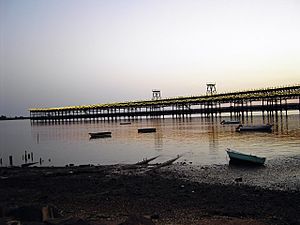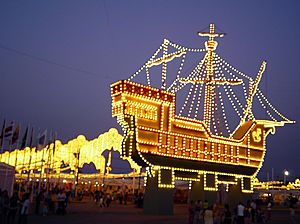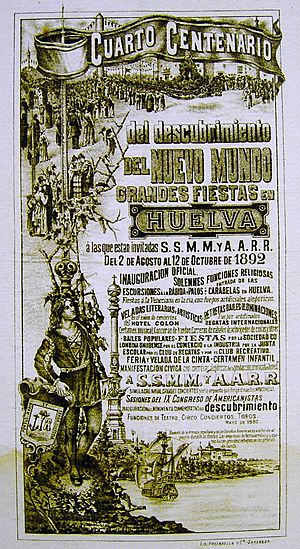Columbian Festivals facts for kids
The Columbian Festivals (also known as Las Colombinas) are big yearly parties in Huelva, a city in Andalusia, Spain. These festivals celebrate the amazing first trip of Christopher Columbus across the Atlantic Ocean. They happen for about a week, usually at the end of July and beginning of August. The most important day is August 3rd. This is because on August 3, 1492, Columbus left Palos de la Frontera on his journey to the Americas. These festivals are so important that they have been named a "National Tourist Interest" event in Spain.
Contents
How the Festivals Started
The Columbian Festivals are special because, unlike many other festivals in Andalusia, they are not based on religion.
Huelva has had religious festivals for a long time, even since the 1600s. For example, there's a special day in September for the city's patron saint, the Virgin of La Cinta. But in the late 1800s, people wanted to celebrate Huelva's important role in Columbus's first voyage. This journey led to what was then called the Discovery of the Americas.
As the 400-year anniversary of Columbus's voyage got closer, people wanted to highlight the Lugares colombinos. These are the places in Moguer and Palos de la Frontera that were connected to the trip. A group called the Real Sociedad Colombina Onubense (Royal Columbian Society of Huelva) started this movement around 1880.
The very first Columbian Festivals were a huge hit in Huelva and nearby Palos de la Frontera. To show the connection to the sea, important navy leaders attended. Several ships from the Spanish Navy were also there. More than 15,000 people gathered at the Monastery of La Rábida in Palos. They watched a "disembarkation" (landing) by the Spanish navy and enjoyed a fireworks show.
Even though Huelva already had the La Cinta festival, the new Columbian Festivals quickly became popular. In the early years, the celebrations included outdoor church services, writing contests, visits to La Rábida, and traditional sports.
Growing Bigger and Changing Over Time
Starting in 1925, the festivals began to grow into a massive party at the city's docks. This is when they started to look more like a typical Andalusian fair. They added special booths (called casetas), fun rides, raffles, and areas for dancing.
Local newspapers from that time showed how important the festivals were. For example, in 1924, a newspaper wrote: "Every day you can see more excitement for these patriotic festivals. They are much bigger than the celebrations in earlier years."
They also talked about the special lights for the festivals: "Beautiful arches have been placed on the waterfront and other promenades. These will create amazing lights that everyone is already celebrating."
The Spanish Navy also played a big part: "It is expected that several warships will anchor in our waters. The president of the Columbian Society has received a letter saying that as many ships as possible will come to Huelva."
And about the special events on August 3rd: "As usual, on the third, Huelva's officials and members of the Columbian Society will go to La Rábida. There, they will have a mass to remember the one Columbus and his brave crew heard before leaving Palos."
Over the years, the Columbian Festivals became Huelva's main celebration. They grew bigger than religious or school festivals. They became a huge entertainment event with many people attending. The festival outgrew its spot by the water. So, in 1943, it moved to a larger area called the Interior Port of Huelva.
Even with this move, the strong "sea spirit" of the festival started to fade. The mayor at the time, Francisco Montenegro, even complained about it. He said that the festivals he knew as a child felt more special. They had more of a "flavor of the sea" and more emotion. He remembered when battleships filled the streets with sailors in white uniforms.
By 1965, the festivals moved again, about a kilometer south of the city. This new spot was near where the Estadio Nuevo Colombino (New Columbian Stadium) is today. The fair setup was similar to what it is now. The booths were large, permanent buildings, open to enjoy the cool August nights. Three years later, a bullfighting arena, Plaza Monumental de Toros de Huelva, opened next to the fairgrounds. It was later taken down in the 1990s.
During this time, Huelva was growing economically. Many new businesses set up their own booths at the fair. However, the festivals saw a decline in the late 1900s. The city government needed land for a new football (soccer) stadium. So, the fairgrounds moved again in the year 2000. That year, a new tradition started: each year, the main entrance gate is designed to look like an important building or place from the province.
Las Colombinas Today

Today, Las Colombinas is one of the most important fairs in Andalusia. It is still a "National Tourist Interest" event. More than 600,000 people visit the fair, which mostly happens at night. Since 2000, the fair has been located along the Huelva estuary. This is very close to its location from 1965 to 1999 and not far from the city center, right next to the Estadio Nuevo Colombino.
Visitors enter the fair through a special gate. This gate is designed to look like a famous building or symbol of Huelva or its province. Examples include the "La Rábida" Institute, Casa Colón, the bullring of La Merced, the Gran Teatro, the Sanctuary of the Virgin of El Rocío, or even Columbus's ship, the Santa María.
The fair area is about 31,818 square meters (342,487 square feet). It has 68 booths, which look similar to those at the Seville Fair, with blue and white awnings. The streets inside the fairgrounds are named after famous places in Huelva. These include Muelle del Tinto, De las Canoas, Marismas del Titán, Punta del Sebo, and Club Marítimo de Huelva. There is also an area with about 70 fun rides and attractions.
The celebrations end with a performance of the Himno de Huelva ("Anthem of Huelva"). This is a special song called a pasodoble titled Mi Huelva tiene una ría by Maestro Molero. After that, there's a 45-minute fireworks show put on by experts from Valencia.
Each year, the festivals are dedicated to a different Spanish city, a Latin American country, or an important local event. In recent years, they have honored places like Palos de la Frontera and Moguer, countries like Cuba, and cities like San Sebastián. They have also celebrated the Canary Islands, Galicia, the Algarve (in Portugal), Almería, Madrid, and Ceuta. Other dedications have included Huelva's special food products (Denominaciones de origen), the El Rocío pilgrimage, the local football team Recreativo de Huelva, and the history of the festivals themselves. In 2008, they celebrated Huelva being a provincial capital for 175 years.
Bullfighting
Bullfights at the Plaza de Toros de La Merced are a big part of the Columbian Festivals. They are like a separate festival within the main one and are very popular. They start a few days before the main festival with an opening event at the "León Ortega" School of Art.
Special Things About Las Colombinas

Even though the Columbian Festivals have a strong Andalusian style, they also have an "Americanist" side. This means they connect to the Americas. Some booths might play music from different Latin American countries. Others play typical Andalusian music for dances like sevillanas, which are part of flamenco. However, unlike most Andalusian fairs, people usually don't wear traditional Andalusian clothing here.
The festivals also include many cultural and sports activities. "Música Junto a la Ría" ("Music along the estuary") is a series of concerts featuring bands from Huelva and other parts of Spain. There's also the Trofeo Colombino golf tournament, and competitions in pétanque, archery, and handball.
A few nautical (sea-related) traditions are still part of the festivities. These include the Semana Náutica Colombina (Columbian Nautical Week), which works with the Club Marítimo. There are also fishing competitions from a docked pier and canoeing races.
The Trofeo Colombino football (soccer) tournament, hosted by Recreativo de Huelva at the Estadio Nuevo Colombino, used to be part of the Columbian Festivals. But now, it's held later in August.
Food at the Festivals
The food at the festivals is a great chance to try delicious dishes from Huelva and Andalusia. You can find fried seafood, like different types of shrimp from the Gulf of Cádiz. These include langostino, the "white prawn" (Parapenaeus longirostris), coquina (a type of clam), and cuttlefish.
Traditional meat dishes include pinchitos, which are skewers of marinated pork, dried meat (cecina), and ham. Some booths specialize in making a drink called "ponche colombino" ("Columbian punch"). A chamomile drink (manzanilla) is also very popular.
See also
 In Spanish: Fiestas Colombinas para niños
In Spanish: Fiestas Colombinas para niños




